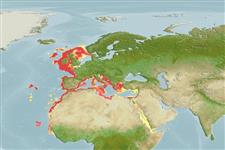Common names from other countries
Classification / Names / Names
आम नाम | उपशब्द | Catalog of Fishes (gen., sp.) | ITIS | CoL | WoRMS
Environment: milieu / climate zone / depth range / distribution range
पारिस्थितिकी
ड़िमरसल; गहराई सीमा 68 - 431 m (Ref. 114857). Subtropical, preferred 24°C (Ref. 107945); 61°N - 28°S, 21°W - 47°E (Ref. 275)
Eastern Atlantic, the Mediterranean and Western Indian Ocean: 20°N to 60°N, west African coast south to the Canary Islands and the Red Sea except Baltic Sea. Subtropical to polar waters.
Length at first maturity / आकार / वज़न / Age
Maturity: Lm ?, range 16 - ? cm Max length : 93.7 cm ML पुल्लिंग / अलिंग; (Ref. 275); 41 cm ML (female)
Maximum size for males is 93.7 cm, mantle length (Ref. 104052). Caught with very small boats, using jigs in daytime at depths of 80 to 100 m (Ref. 2760). Occurs in tropical and subtropical climates (Ref. 275). Found In inshore waters over rocky ground at the start of the season and on sandy or muddy bottom later in the season (Ref. 106900). Feeds on small, juvenile fishes, other cephalopods, crustaceans, polychaetes (Ref. 275).
Members of the class Cephalopoda are gonochoric. Male and female adults usually die shortly after spawning and brooding, respectively. Mating behavior: Males perform various displays to attract potential females for copulation. During copulation, male grasp the female and inserts the hectocotylus into the female's mantle cavity where fertilization usually occurs. Life cycle: Embryos hatch into planktonic stage and live for some time before they grow larger and take up a benthic existence as adults.
Roper, C.F.E., M.J. Sweeney and C.E. Nauen. 1984. (Ref. 275)
IUCN Red List Status (Ref. 130435)
CITES status (Ref. 108899)
Not Evaluated
Not Evaluated
Human uses
मात्स्यिकी: व्यापारिक
FAO - मात्स्यिकी: landings | FishSource | Sea Around Us
साधन
इंटरनेट स्रोत
Estimates based on models
Preferred temperature
(Ref.
115969): 7.3 - 16.2, mean 10.6 (based on 229 cells).
Vulnerability
High vulnerability (56 of 100).
